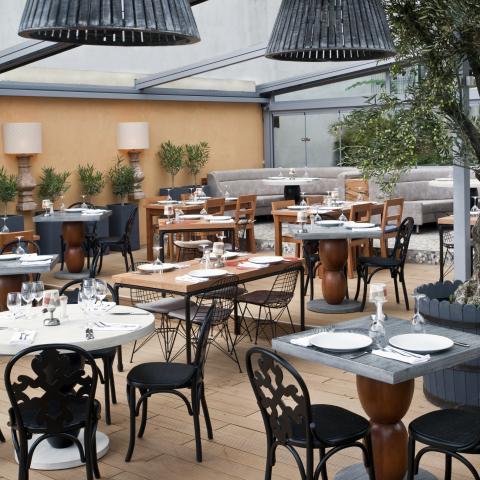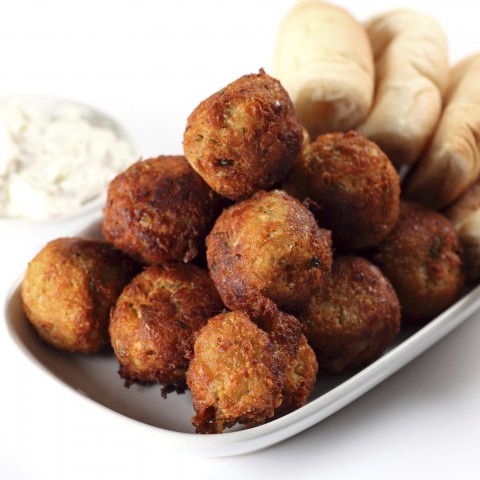
The best way to remember things is to connect them with your senses in some way. Remembering new words and rules on paper is a tough task unless you also have something you can feel. Something in the heart.
And they always say food is the best way to the heart.
Fortunately for you, you’ve chosen to learn Arabic—a language spoken across an enormous cultural and culinary tapestry.
In this article, you’ll get the barest glimpse at the amazing diversity on display in the world of Arab food. You’ll even learn some interesting Arabic phrases to go along with your meal!
 Table of Contents
Table of Contents
- What They Eat in Arabic-Speaking Countries
- In-Country vs. Overseas
- Unique Food You Can Only Get Abroad
- Food-Related Vocabulary
- Bonus: Simple Recipes to Practice at Home
- Conclusion
1. What They Eat in Arabic-Speaking Countries

Every country has a national dish (whether or not it’s actually favored by most of the citizens). Since the Arabic language is spoken in so many different places, it’s only fitting that we introduce several different national dishes across the spectrum.
A- كُسْكُس (Kuskus) – Couscous
Algerian national dish.
You’ve probably had couscous before, even if you had no idea what it was made of or where it came from. That’s because this grain dish of tiny wheat balls is also used in French cooking and is a staple in some American supermarkets. The name itself comes from the Berber languages, spoken in different areas of North Africa.
B- كبسة (Kabsah) – Kabsa
Saudi national dish.
The word كبس (kabasa) means “to press” or “to squeeze,” referring to the way rice, meat, vegetables, and spices are all pressed into one pot. It’s sometimes served with tomato sauce.
C- المسكوف (Masgouf)
Iraqi national dish.
The Tigris and Euphrates are massive rivers flowing through Iraq into the Persian Gulf, and they’re also home to huge numbers of carp. To prepare masgouf, one splits open a carp, seasons it with various spices and olive oil, and then slow-cooks it in a special grill for several hours.
D- كشري (Koshari)
Egyptian national dish.
Kushari is hardly an ancient Egyptian recipe. Rather, it has its roots in the beginning of Egypt’s economic boom of the 1800s when people were coming to the country from all over the world. It’s a street food with rice, pasta, and lentils mixed together, and served with spicy tomato sauce and vinegar.
E- منسف (Mansaf)
Jordanian national dish.
This one may be what you think of when you imagine “Arab cuisine.” It’s a large platter of stewed lamb and rice topped with fermented goat’s milk. Traditionally, it’s eaten standing up with the right hand only, though you can also eat it with spoons and plates.
2. In-Country vs. Overseas

It’s not just words that can be lost in translation. Recipes that get exported around the world definitely undergo some changes on the journey, whether to suit local palates or just because different ingredients are available in different places.
Take the popular Middle Eastern food حُمُّص (hummus), for example. In the United States, you can find it in the grocery store next to salsas and guacamoles as a refrigerated dip for appetizers. In the Middle East, though, it’s usually prepared fresh and eaten the same day.
Also, you can forget about finding carrot hummus, cauliflower hummus, or sweet potato hummus in ordinary restaurants in the Middle East. The word itself means “chickpeas,” and that’s exactly what you’re going to get.
Next, most people are used to seeing white rice on the menu in Middle Eastern restaurants abroad. That’s definitely a staple, but other grains made from wheat are also quite popular. برغل (Bulgur) and semolina are two more grains that commonly show up in traditional Arab cuisine, as well as فريكة (freekeh), a cereal made from green wheat.
3. Unique Food You Can Only Get Abroad

Some foods can only be found in one country, yet they’re so popular that language learners should know about them. After all, wouldn’t it be great to use your Arabic language skills to order something you couldn’t get back home? Here are a few popular examples of authentic Arab cuisine:
A- مطبق (Muttabak)
This is a type of omelette pancake with green onion, minced meat, and occasionally other sweet or savory ingredients. The word itself means “folded,” and this type of street food can even be found in Southeast Asian Muslim countries like Malaysia and Indonesia.
B- كُنافة (Kanafeh)
The kanafeh is a small cake made of super-fine pastry dough soaked in sweet syrup, deep-fried, and served with cheese and nuts. Pistachios are the most common topping. Since these can take a little while to make properly, there are also easier variants which are rolled instead of layered.
- → You can read about more Arab dessert items in our lesson on Arab Sweets and Desserts!
C- مَحشي (Mahshi)
This is a type of stuffed squash served as a main course or as finger food in Egypt and the Levant. It’s similar to dolmas, but the typical “wrapping” is zucchini or eggplant instead of vine leaves.
4. Food-Related Vocabulary

Now it’s time to stop eating and start learning with these restaurant words and phrases in Arabic.
You should be aware (if you aren’t already) that walking into an ordinary restaurant in Jordan, Tunisia, Morocco, or any other Arabic-speaking country is going to be a different linguistic environment than what you’re learning in your textbooks. It’s going to be a bit weird if you order in MSA instead of the local dialect.
That said, even if your Modern Standard Arabic is far from beautifully correct, people will greatly appreciate your efforts to connect with the local culture. For that reason, these phrases will be given in MSA.
We’ll cover three different and very useful types of things you might want to say during the course of your restaurant visit.
A- Asking About Meat
Arab cultures overall have nothing against vegetarianism. Although some specific festivals are associated with meat—and although lamb, beef, and poultry are staples of plenty of dishes—there are vegetarian options at any restaurant.
However, when you get the menu, you’ll almost certainly be overwhelmed by Arabic names for dishes you may not recognize, perhaps accompanied by clumsy machine translations.
In those cases, you should ask the waiter directly:
هَل هُناكَ لَحمٌ في هَذا الصَحن؟
hal hunāka laḥmun fī haḏā al-ṣaḥn?
“Does this dish have meat in it?”
It’s possible that the person you speak to might not grasp what you’re saying through the language or culture barrier (after all, if you’re in a smaller place, you might be one of only a few vegetarians that passes through). Try explaining in a different way:
َأنا لا آكُلُ اللَحم.
aʾnā lā ʾākulu al-laḥm.
“I don’t eat meat.”
B- Price and Payment
Once you’ve had your fill, you’ll want to know the damage to your wallet. In many places, such as Lebanon, restaurant culture is more about service than it is in the U.S., and you won’t be given the bill unless you ask for it. (Otherwise, the wait staff would feel as though they’re pressuring you to leave.)
الحِساب، مِن فَضلِك.
al-ḥisāb, min faḍlik.
“The bill, please.”
C- Complimenting the Food
It may come across as oddly charming to some people if they’re not used to it, but a genuine compliment about the food goes over well anywhere.
طَعمُهُ رائِع!
ṭaʿmuhu rāʾiʿ!
“This tastes amazing!”
5. Bonus: Simple Recipes to Practice at Home

Ready to get cooking? Here are two very easy Arab cuisine recipes you can make at home!
A- How to Make فَلافِل (Falafel)
Falafel is a dish with roots in Egypt and popularity all over the world. It’s both delicious and easy to make! There are two types of falafel: chickpea falafel which is mostly eaten in the Levant, and fava bean falafel which is eaten in Egypt. Here, we’ll introduce the Levantine Falafel.
Once you have it ready,
1. First, soak dried chickpeas in a bowl of water for an evening or a day in advance.
2. Then combine the chickpeas with parsley, cilantro, mint, onions, and garlic, and add some spices such as salt, pepper, cumin, and cardamom.
3. Throw those in a food processor for a little while. Then refrigerate that for fifteen minutes or so, form them into balls, and fry in hot oil.
They’re best to eat right away, served hot and with additional salt or dipping sauce to taste.
B- How to Make فتوش (Fattoush)
1. Brush pita bread with olive oil and sprinkle on salt. Break into pieces and bake into croutons.
2. Combine fresh greens (such as purslane or romaine), mint leaves, sumac, tomato, cucumber, and croutons.
The typical signature Fattoush is served with a lemon dressing, though if you don’t have it on hand, try a mint dressing instead. The sumac adds a bit of lemon zest anyway!
6. Conclusion
As we mentioned, there’s really so much to cover when it comes to Middle Eastern cuisine that you could spend a lifetime studying only the food.
Fortunately, any aficionado of the topic already knows a lot of Arabic words just from the food names, like hummus or couscous.
These and other words will pop up often when you use ArabicPod101 to learn and retain your Arabic vocabulary.
In order to keep you motivated during the long journey of learning Arabic, why not check out some interesting cooking channels or food vloggers who use Arabic to share their love of food? You’ll get inspired to create new meals and learn Arabic at the same time—a delicious win-win scenario!
Which Arabic food are you most looking forward to trying, and why? Let us know in the comments!










